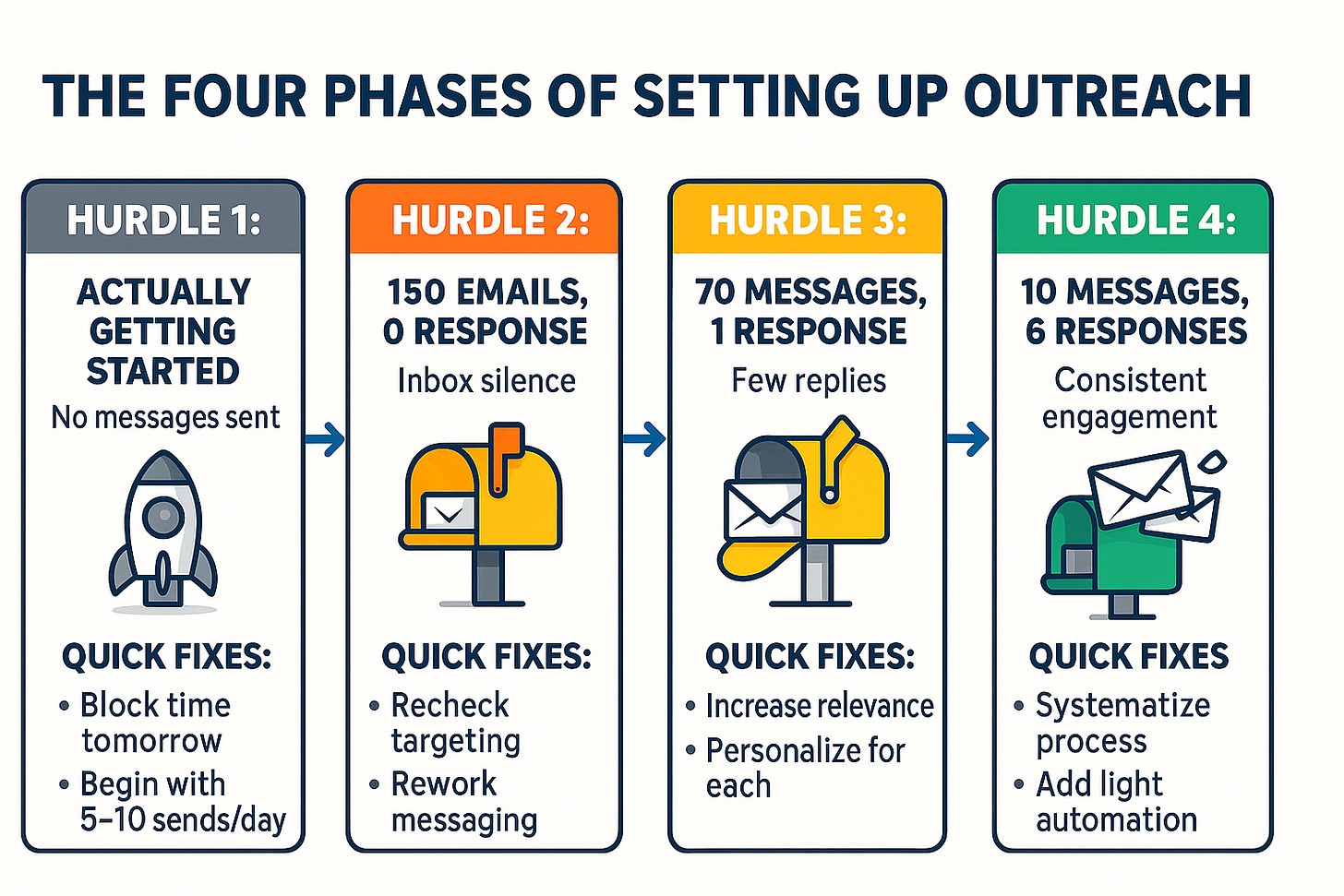The four hurdles of manual outreach
Tactics to improve your outbound messaging
Early traction often depends on getting in front of the right people, and in the early days, they’re not going to find you
95%1 of founders are forced to start with manual outreach and sales
Cold outreach is rarely anyone’s favourite activity
Often, founders feel lost in this process
Here’s how it feels to set the early stages up
The basics
At its core, outreach boils down to three things:
Targeting the right people
The more specific, the better
More about how targeting works here
Sending the right message
Short, relevant, and framed around their needs, not your pitch.
Sending enough messages
15-20 handcrafted messages per day for a month leads to 500 messages
With 5%2 conversion rate → 25 meetings
A 10% closing rate → ±2 sales.
The four hurdles
In mentoring dozens of startups on setting up outreach, I have identified four hurdles in the process.
Hurdle 1: Actually Getting Started
Most early-stage founders stall here. You know outreach matters, but you put it off — “We’ll do it once the website is updated,” or “We just need one more product tweak.” Really, it’s fear of rejection disguised as “prep work.”
Things to do right now:
Block 60 minutes tomorrow for sending outreach messages.
Commit to a small, daily send goal (e.g., 5–10 messages).
Use LinkedIn search, Crunchbase, or industry directories to create your first list of 25 potential leads.
Don’t overthink — just get the first batch out.
Hurdle 2: 150 Emails, 0 Responses
The dreaded silence phase. Usually caused by bad targeting (wrong people) or self-centred messaging (“Here’s our amazing product…”).
Things to do right now:
Recheck your list: Are these people really your early adopters?
Rewrite your email so the first line talks about their world, not your product.
Test different subject lines — curiosity and relevance beat generic headlines.
Send to a small subset first, then adjust before blasting.
🏝️ End-of-summer deal: Get 90% off the first sparring session! 🏝️
30 minutes with me, no strings attached. You bring your challenges, and I help to fix them.
Hurdle 3: 70 Messages, 1 Response
Some signs of life — you’ve found relevant prospects, but the message still misses for most.
Things to do right now:
Personalise the first sentence for each recipient.
Reference a specific pain point or industry trend they care about.
Add a short case study or proof point (but keep it to one line) of your startup
‘With X, we’ve helped Company Y to achieve Z’.
Experiment with a softer call-to-action like “Worth a quick chat?” instead of “Schedule a demo.”
Hurdle 4: 10 Messages, 6 Responses
Now you’ve nailed targeting and messaging — most people at least respond, even if it’s “not right now.”
Things to do right now:
Systematise your process: templates, lists, and cadence.
Start using light automation to scale without losing personalisation.
Track open and reply rates to continuously improve.
Build a follow-up sequence for non-responders — many replies come after the second or third touch.
Tips on writing great messaging
Focus on message-market fit
Take time to rewrite your messages, here’s How to - with simple fixes, by Yuri
Do you run an accelerator, and are your startups struggling with their product-market fit? They don’t understand the concept and focus on the wrong things? My single workshop on product-market fit fixes this.
Made up a number for dramatic effect. Based on my experience, it might be 99%.
Again, just a rough number. It will be somewhere between 1% and 20%. But not 50%.



Solid advice. The 60-minute block is the only way it ever actually happens.
I guess my question is how much of this can be automated?